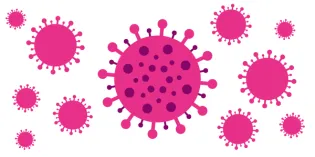Definition
Reye’s syndrome is a rare and serious illness, occurring almost exclusively in children, which can appear after a viral infection such as flu or chickenpox. The exact cause of Reye’s syndrome is unknown; however, the disease has been associated with damage to cell mitochondria during a viral illness.1
Reye’s syndrome predominantly affects functions of the liver and brain.2
Symptoms of Reye’s syndrome include continuous vomiting, listlessness, drowsiness, irritability, confusion, irrational behaviour, convulsions or coma.3
Unless diagnosed and treated quickly, Reye’s syndrome can be fatal or result in severe disability.4
History of the condition
Reye’s syndrome was first named in 1963, by Australian pathologist, R. Douglas Reye in a study in The Lancet. Reye, with fellow pathologists Graeme Morgan and Jim Baral suggested Reye’s syndrome as a distinct ‘clinicopathological entity’ in children presenting with disease of the liver and brain following a viral illness.5
However, the syndrome may first have been recognised in 1929.6
Over the next decades, case-controlled studies of Reye’s syndrome took place. These began in the United States after outbreaks of Reye’s syndrome occurred following influenza-like illnesses. Many studies demonstrated a strong association between ingestion of aspirin during viral illness and the development of Reye’s syndrome.7
In the United Kingdom, surveillance of Reye’s syndrome began in 1981, thereafter becoming one of the first conditions monitored by the British Paediatric Surveillance Unit (BPSU), which was founded in 1985.8
Cases of Reye’s syndrome declined from the mid-1980s onwards as research into and awareness of the condition increased. There have been no reported cases of classical Reye’s syndrome in the UK since 2002.9
Reye-Like disorders
There are many genetic metabolic disorders which may result in a presentation similar to Reye’s syndrome, these can be described as ‘Reye-like’ inherited metabolic disorders.10
In the UK, newborn babies are offered blood spot screening which tests for rare disorders, including some ‘Reye-like’ disorders.11
The National Reye’s Syndrome Foundation (NRSF)
The NRSF was formed in the UK in 1983 to provide funds for research into the cause, treatment, cure and prevention of Reye’s syndrome and Reye-like illnesses. The foundation also sought to raise awareness of these conditions in public and medical communities.12
The NRSF holds several notable achievements, including research and campaigning which led to the introduction of warning labelling on aspirin products in the UK in 1986, prompting a dramatic decline in Reye’s syndrome cases. The Foundation also produced publications aimed at medical professionals and parents raising the profile of Reye’s Syndrome and emphasising the need for quick diagnosis and treatment. In March 2002, the Foundation funded the ‘Workshop on Reye's Syndrome and Reye Like Disorders’. A result of this workshop was the recommendation and implementation of a formal evidence-based guideline on the diagnosis and management of disordered consciousness in children.13
The NRSF became part of the RCPCH in 2012, and records of the NRSF are held in the RCPCH archive.
Relevant records held at RCPCH
• Records of the National Reye's Syndrome Foundation of the United Kingdom (1929-2024)
Ref: NRSF. Records of the National Reye's Syndrome Foundation (NRSF) including the papers of the founders of the charity, Audrey and Clifford Harrington, alongside records of Gordon Denney, and the papers of Dr Susan Hall.
• Records relating to Reye’s Syndrome (1985-1986)
Ref: RCPCH/007/381. Correspondence and reports relating to Reye’s Syndrome and the link between aspirin.
• Correspondence and comments on Notification of Unusual Diseases (1985)
Ref: RCPCH/003/049/001/017. Letters regarding comments on the notification of unusual diseases, including Reye’s Syndrome.
- 1Bellman MH, Hall SM Aetiology of Reye's syndrome. Archives of Disease in Childhood 1983;58:670-672
- 2Bellman MH, Hall SM Aetiology of Reye's syndrome. Archives of Disease in Childhood 1983;58:670-672
- 3reyessyndrome.rcpch.ac.uk/about-reyes-syndrome/introduction/ Accessed 14/10/2025
- 4reyessyndrome.rcpch.ac.uk/about-reyes-syndrome/introduction/ Accessed 14/10/2025
- 5Reye, R.D.K. et al. Encephalopathy and Fatty Degeneration of The Viscera A Disease Entity In Childhood, The Lancet, 282:7311: 749 – 752
- 6Mowat AP, Encephalopathy and fatty degeneration of viscera: Reye's syndrome. Archives of Disease in Childhood 1973;48:411-413
- 7McGovern, M. C., Glasgow, J. F., & Stewart, M. C. (2001). Lesson of the week: Reye's syndrome and aspirin: lest we forget. BMJ (Clinical research ed.), 322(7302), 1591–1592. doi.org/10.1136/bmj.322.7302.1591
- 8Hall SM, Glickman M, The British Paediatric Surveillance Unit. Archives of Disease in Childhood 1988;63:344-346
- 9reyessyndrome.rcpch.ac.uk/about-reyes-syndrome/causes/ Accessed 14/10/2025
- 10reyessyndrome.rcpch.ac.uk/reye-like-syndromes/ Accessed 14/10/2025
- 11reyessyndrome.rcpch.ac.uk/reye-like-syndromes/ Accessed 14/10/2025
- 12reyessyndrome.rcpch.ac.uk/about-us Accessed 14/10/2025
- 13reyessyndrome.rcpch.ac.uk/about-us Accessed 14/10/2025










